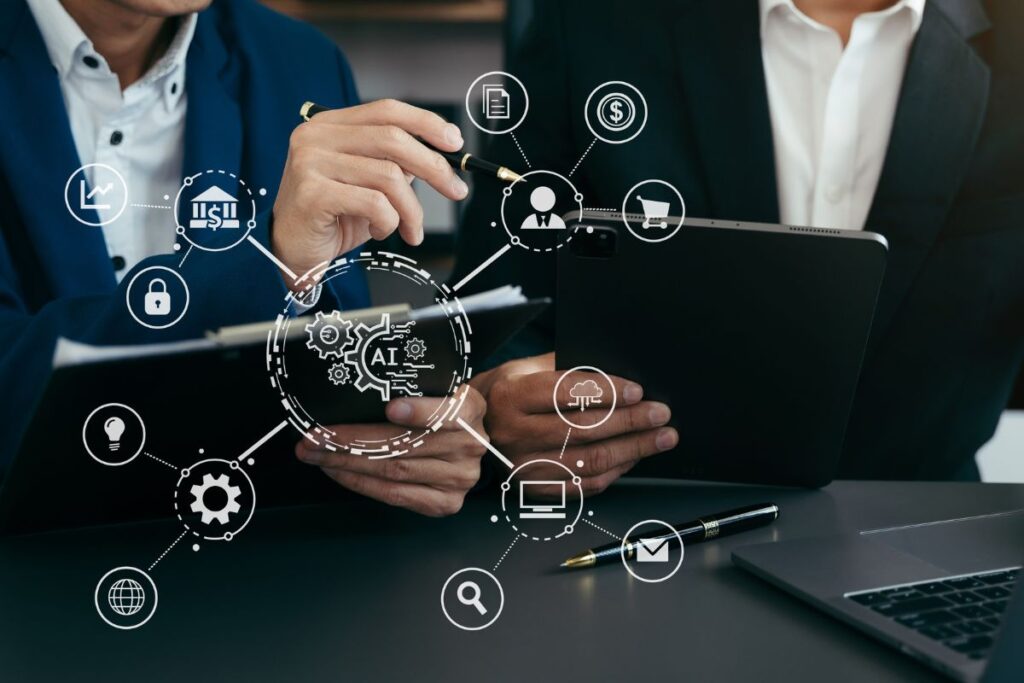Cloud Adoption Strategies for Small Businesses

Cloud computing has revolutionized the way small businesses operate, offering access to powerful tools, improved scalability, and cost efficiencies that were once available only to large enterprises. As the digital landscape evolves, adopting cloud technology is no longer optional—it’s essential for staying competitive. This article outlines practical cloud adoption strategies for small businesses, ensuring a smooth transition to the cloud while maximizing its benefits. Why Cloud Adoption Matters for Small Businesses Steps for Successful Cloud Adoption 1. Define Business Objectives Before moving to the cloud, it’s crucial to identify what you aim to achieve. Are you looking to reduce costs, improve data accessibility, or enhance your software capabilities? Defining these objectives will help in choosing the right cloud solution. 2. Evaluate Current IT Infrastructure Conduct a thorough assessment of your existing IT setup. Identify applications and systems that can be moved to the cloud and those that may need to remain on-premises. 3. Choose the Right Cloud Model Small businesses can choose from: 4. Select a Trusted Cloud Provider Look for providers with a strong track record, excellent customer support, and services tailored to small businesses. Popular options include: 5. Develop a Migration Plan Create a detailed roadmap for migrating data and applications. Prioritize non-critical systems first to minimize disruptions. Backup data to avoid loss during the migration process. 6. Invest in Employee Training Provide training sessions to familiarize employees with cloud-based tools. Encourage a culture of continuous learning to adapt to evolving technologies. 7. Implement Robust Security Measures While cloud providers offer strong security, small businesses must also: Best Practices for Maximizing Cloud Benefits Start Small and Scale Gradually Begin with one or two critical applications and expand as your team becomes comfortable with the new environment. This phased approach reduces risks and ensures smoother integration. Optimize Costs Regularly review cloud expenses and adjust resource allocation to prevent over-provisioning. Many providers offer cost-management tools to help track usage. Leverage Cloud Automation Use automation to streamline repetitive tasks, such as data backups and system updates, freeing up time for strategic activities. Monitor Performance Continuously monitor system performance and uptime to ensure the cloud is meeting your business needs. Cloud providers often offer analytics dashboards for real-time tracking. Stay Compliant Ensure your cloud adoption complies with industry regulations like GDPR or HIPAA, depending on your business’s domain. Challenges in Cloud Adoption and How to Overcome Them 1. Initial Costs While the cloud reduces long-term expenses, initial migration and training costs can be high. Solution: Start with essential systems and leverage free trials. 2. Data Privacy Concerns Storing sensitive data in the cloud can raise security concerns. Solution: Choose providers with end-to-end encryption and data residency options. 3. Lack of Expertise Small businesses may lack in-house expertise for cloud management. Solution: Partner with managed service providers (MSPs) to bridge the skills gap. 4. Downtime During Migration Service disruptions during migration can affect operations. Solution: Plan migrations during off-peak hours and test systems extensively before going live. The Future of Cloud Computing for Small Businesses The future of cloud computing is bright, with emerging technologies like artificial intelligence (AI), machine learning (ML), and the Internet of Things (IoT) becoming more accessible through cloud platforms. Small businesses that adopt these innovations early will gain a competitive edge, streamlining processes and enhancing customer experiences. Conclusion Adopting cloud technology is a transformative step for small businesses. By following a structured approach, from defining objectives to implementing best practices, businesses can leverage the cloud to reduce costs, improve scalability, and enhance security. While challenges exist, the long-term benefits far outweigh the risks, making cloud adoption a worthwhile investment. Take the first step today and explore cloud solutions tailored to your business needs—your future success starts in the cloud. For more insights, follow The Business Tycoon
Justin Trudeau Resigns as Prime Minister of Canada Amid Party Dissent

In a surprising turn of events, Justin Trudeau Resigns as Prime Minister of Canada and leader of the Liberal Party. The decision marks the end of a nine-year tenure that has been increasingly marred by dissent within his party and declining public support. Addressing the nation from Rideau Cottage, Trudeau confirmed his plans to step down once a successor is chosen through a competitive process. “I have informed my party and the Governor that I intend to resign as leader of the party and prime minister of Canada,” Trudeau stated. “This will take effect once a robust nationwide process selects my replacement.” A Paralysed Parliament Justin Trudeau’s resignation follows months of turmoil within the Liberal Party. He admitted in his speech that the current parliament is “paralysed” under his leadership. In a move to facilitate a smoother transition, Trudeau announced the prorogation of Parliament until March 24, allowing the Liberal Party to elect a new leader who will guide the party into the upcoming elections. “I remain committed to the party’s values and ideals,” Trudeau said, adding, “A new leader will continue to carry those forward.” The Road to Resignation The phrase “Justin Trudeau resigns” has been echoing across political circles and media outlets in recent weeks. Trudeau’s leadership faced growing criticism, with opinion polls showing a significant surge in support for the opposition Conservative Party. The tipping point came with the resignation of Chrystia Freeland, the Deputy Prime Minister and Finance Minister, who left over policy disagreements, including Trudeau’s economic strategies. Freeland’s departure triggered a wave of discontent among senior party members, many of whom publicly called for Trudeau to step down. Over 20 Liberal MPs reportedly signed a petition urging him to resign, further solidifying the demand for change. Potential Successors As Justin Trudeau resigns, speculation is rife about his potential replacements. Front-runners include: Trudeau’s Legacy and Regrets Reflecting on his tenure, Trudeau expressed regret about not reforming Canada’s electoral system. He argued that the current setup fuels polarisation and limits voters’ ability to express nuanced preferences. While Trudeau highlighted his efforts in combating climate change and promoting diversity, he did not shy away from criticising the opposition. He questioned the vision of Pierre Poilievre, leader of the Conservative Party, calling it “misguided” and lacking ambition. Economic and Geopolitical Struggles Trudeau’s resignation comes amid economic challenges, including high inflation, stagnant GDP growth, and trade disputes. The Canadian dollar, which had been declining, showed signs of recovery following the announcement that Justin Trudeau resigns as leader. Geopolitically, Trudeau’s administration faced criticism for its handling of relations with India. His allegations of Indian involvement in the killing of Khalistani terrorist Hardeep Singh Nijjar led to a diplomatic fallout, further straining ties between the two nations. A Leadership in Transition While Justin Trudeau resigns, he will remain as caretaker Prime Minister until the Liberal Party elects a new leader. The process could take weeks or months, leaving the political landscape uncertain as Canada prepares for elections later this year. Trudeau’s departure signals a pivotal moment for Canadian politics. His leadership, once seen as a beacon of progressive values, has been overshadowed by internal dissent and public dissatisfaction. As the nation awaits his successor, the future of the Liberal Party—and Canada—hangs in the balance. For more insights, follow The Business Tycoon
From Prevention to Treatment: A Comprehensive Approach to Health Management

The path to a healthier life starts with prevention and extends through effective treatment. This holistic approach emphasizes the importance of avoiding illnesses and ensuring timely and efficient treatment when health issues arise. By integrating prevention to treatment methods, individuals and healthcare providers can work together to improve outcomes and enhance quality of life. This article explores the crucial role of prevention, highlights effective diagnostic techniques, and delves into modern treatment methods that bridge the gap between avoiding illness and recovering from it. Understanding Prevention: The First Line of Defense What is Prevention? Prevention in healthcare refers to strategies and actions aimed at avoiding the onset of diseases. These measures, whether individual or collective, significantly reduce healthcare costs and improve public health. Types of Prevention Key Strategies for Effective Prevention From Detection to Diagnosis Prevention to treatment intersect at detection, making accurate and timely diagnosis a cornerstone of effective healthcare. The Importance of Early Detection Early diagnosis improves treatment efficacy, reduces complications, and often leads to better patient outcomes. For instance, cancers detected at an early stage often have higher survival rates compared to late-stage detection. Modern Diagnostic Tools Technological advancements have revolutionized diagnostic practices: Artificial Intelligence in Diagnostics AI-powered tools analyze vast datasets to detect patterns, enabling quicker and more accurate diagnoses. For instance, AI algorithms can analyze medical images for early signs of diseases like diabetic retinopathy or breast cancer. Treatment: Bridging the Gap Once a diagnosis is established, effective treatment becomes the priority. The evolution of medical sciences has introduced innovative therapies and approaches that cater to a diverse range of health challenges. Conventional Treatment Methods Advancements in Treatment Integrating Prevention to Treatment: A Holistic Model The future of healthcare lies in integrating prevention to treatment seamlessly. This model ensures that preventive measures reduce the incidence of diseases, while advanced treatments manage conditions effectively when they arise. Collaborative Healthcare The Role of Policy and Advocacy Governments and organizations must implement policies that promote preventive care while ensuring access to quality treatments. Subsidized vaccination programs and funding for healthcare innovations are examples of effective strategies. Conclusion The journey “From Prevention to Treatment” underscores the importance of a balanced approach to health management. Preventive measures provide the foundation for reducing disease burden, while advanced diagnostic and treatment methods ensure comprehensive care. By adopting this integrated approach, individuals can lead healthier lives, and societies can experience reduced healthcare costs and improved quality of life. The road to wellness is a collaborative effort, requiring active participation from individuals, healthcare providers, and policymakers alike. For more insights, follow The Business Tycoon
US Army Veteran Behind New Orleans Attack “100% Inspired By ISIS”: FBI

A tragic New Orleans attack during New Year’s celebrations has been attributed to Shamsud-Din Jabbar, a 42-year-old US Army veteran reportedly inspired by ISIS. The attack killed 14 individuals and injured over 30 in the French Quarter district before ending in a confrontation with law enforcement. Jabbar was fatally shot after wounding two police officers in an exchange of gunfire. Details of the New Orleans Attack The suspect rented a Ford F-150 pickup truck, which he used to plow into a crowd of revelers, and planted two homemade bombs in drink coolers nearby. The bombs were deemed viable but were successfully neutralized by authorities. Jabbar carried an ISIS flag on his vehicle and had uploaded videos online pledging allegiance to the terrorist organization. In one of these videos, Jabbar revealed he initially intended to target his family and friends but decided against it, believing such an act would not adequately highlight the “war between the believers and the disbelievers.” Investigations and Radicalization Preliminary findings suggest Jabbar acted alone, with no accomplices involved in the planning or execution of the New Orleans attack. FBI Deputy Assistant Director Christopher Raia stated, “He was 100% inspired by ISIS.” The focus of ongoing investigations is now on understanding Jabbar’s path to radicalization. Jabbar’s military background includes service as a human resources and IT specialist in the US Army from 2007 to 2015, with deployment to Afghanistan from 2009 to 2010. He also served in the Army Reserve until 2020. Connection to Las Vegas Incident Just hours after the New Orleans attack, a Tesla Cybertruck exploded outside a Las Vegas hotel owned by US President-elect Donald Trump, resulting in one fatality and seven injuries. While both incidents involved rented vehicles sourced from the same car-sharing app, Turo, authorities have found no definitive link between the two events. Reactions and Fallout New Orleans Police Superintendent Anne Kirkpatrick assured the public of safety ahead of major upcoming events, including the Sugar Bowl and the NFL Super Bowl, despite the New Orleans attack. Meanwhile, President-elect Donald Trump seized the opportunity to renew his anti-immigrant rhetoric on social media, even though the perpetrator was a US-born citizen. Trump criticized law enforcement agencies and demanded CIA involvement, linking the attack to broader issues of national security. Conclusion The New Orleans attack underscores the persistent threat of lone-wolf terrorism and the challenges of identifying and preventing radicalization. As investigators dig deeper into Jabbar’s motives and online activities, the incident serves as a sobering reminder of the evolving nature of domestic threats. For more insights, follow The Business Tycoon
The Future of Cryptocurrency: Balancing Innovation and Regulation

Cryptocurrency has evolved from a niche concept into a global phenomenon reshaping financial systems. With innovation driving its rapid growth, regulatory frameworks are playing catch-up to address risks such as fraud, market volatility, and money laundering. Balancing these elements is critical to the future of cryptocurrency. This article explores emerging trends, the need for effective regulation, and the path forward for this revolutionary technology. The Rise of Cryptocurrency Cryptocurrency began with Bitcoin’s introduction in 2009 as a decentralized, peer-to-peer digital currency. Over the past decade, the market has expanded to include thousands of cryptocurrencies like Ethereum, Binance Coin, and Solana, each serving unique purposes beyond currency, such as smart contracts and decentralized finance (DeFi). Key Factors Behind the Growth Challenges to Growth While innovation fuels growth, the sector faces significant hurdles: The Role of Regulation As cryptocurrencies gain mainstream attention, governments worldwide are grappling with how to regulate the sector without stifling innovation. Why Regulation is Essential Examples of Regulatory Approaches Innovations Shaping the Future Cryptocurrencies are evolving to address limitations and expand their use cases. Decentralized Finance (DeFi) DeFi platforms enable users to borrow, lend, and trade assets without intermediaries. This model challenges traditional banking systems and promotes financial inclusivity. Non-Fungible Tokens (NFTs) NFTs have revolutionized digital ownership, allowing artists and creators to monetize their work in unprecedented ways. Layer-2 Scaling Solutions Technologies like the Lightning Network and Polygon aim to improve blockchain scalability, reducing transaction fees and increasing speed. Central Bank Digital Currencies (CBDCs) Governments worldwide are exploring CBDCs to combine the benefits of cryptocurrencies with state oversight. Striking a Balance To ensure the long-term viability of cryptocurrencies, stakeholders must balance innovation and regulation. Encouraging Innovation Ensuring Regulation Opportunities and Challenges Ahead Opportunities Challenges Conclusion The future of cryptocurrency hinges on achieving harmony between innovation and regulation. As blockchain technology continues to disrupt traditional systems, thoughtful policies must be implemented to protect users and stabilize markets without stifling growth. By fostering collaboration between innovators and regulators, cryptocurrency can fulfill its potential to transform global economies. For more insights, follow The Business Tycoon
Smart Homes and Beyond: Exploring the Impact of IoT on Modern Living

The Internet of Things (IoT) has become a cornerstone of modern living, fundamentally reshaping how we interact with our homes and surroundings. From automated lighting systems to voice-activated assistants, smart homes symbolize a leap in convenience, efficiency, and connectivity. But IoT’s influence extends beyond smart homes, driving innovations in healthcare, urban development, and energy management. This article explores the transformative impact of IoT on modern living, its applications, and the possibilities it holds for the future. The Rise of Smart Homes What Are Smart Homes? Smart homes integrate IoT technology to create an interconnected environment where devices communicate seamlessly. These homes utilize smart appliances, sensors, and software to offer convenience and efficiency. Key Features of Smart Homes Benefits of Smart Homes IoT’s Impact Beyond Homes Healthcare Innovations IoT-enabled devices such as wearables monitor vital signs, track fitness goals, and send real-time data to healthcare providers. Devices like Fitbit and Apple Watch empower individuals to take proactive health measures. Smart Cities IoT drives urban development with applications like: Industrial IoT (IIoT) In industries, IoT improves operational efficiency through predictive maintenance and real-time monitoring, minimizing downtime and increasing productivity. Challenges in IoT Adoption Data Privacy Concerns With increased connectivity comes the risk of data breaches. Securing personal information is critical as IoT devices collect sensitive data. Interoperability Issues Devices from different manufacturers may lack compatibility, leading to fragmented systems. High Initial Costs While IoT technology offers long-term savings, the upfront investment can be a barrier for many consumers. The Future of IoT in Modern Living AI-Driven Smart Systems Artificial Intelligence (AI) will enhance IoT capabilities, enabling smarter decision-making and predictive analytics. Imagine homes that anticipate your needs before you voice them. IoT and 5G The rollout of 5G networks will amplify IoT’s potential by offering faster and more reliable connectivity, enabling real-time data sharing. Sustainable IoT Solutions IoT can contribute significantly to sustainability goals, such as reducing carbon footprints through energy-efficient devices and systems. Conclusion The Internet of Things is revolutionizing modern living, with smart homes as just the beginning of its potential. From enhancing daily convenience to reshaping urban landscapes, IoT’s impact is profound and far-reaching. As technology evolves, IoT promises to make modern living more connected, efficient, and sustainable. Embracing this technology today sets the foundation for a smarter, more innovative future. For more insights, follow The Business Tycoon
A Deadly December for Aviation: At Least 7 Plane Crashes, Hundreds of Lives Lost

December 2024 has been a catastrophic month for aviation, with at least seven deadly plane crashes involving commercial airlines, highlighting serious concerns about aviation safety and emergency response procedures. These tragic events have left hundreds dead, underscoring the vulnerabilities in the aviation industry. Jeju Air Plane Crash in South Korea One of the deadliest plane crashes occurred on December 28 when a Jeju Air flight, attempting to land at Muan Airport in South Korea, lost control due to a malfunction in its front landing gear. The aircraft skidded off the runway, crashing into a concrete barrier and igniting a fierce fire. The fire claimed the lives of 179 of the 181 people on board, leaving only two survivors—a crew member and a passenger. Emergency responders battled the flames with 32 fire trucks and helicopters, but the cause of the landing gear failure remains under investigation. Azerbaijan Airlines Crash in Kazakhstan Earlier, on December 25, an Embraer ERJ-190AR aircraft operated by Azerbaijan Airlines crashed near Aktau Airport in Kazakhstan, killing 38 of the 67 passengers. The flight had been experiencing technical issues and poor weather, and after multiple failed landing attempts, the plane went down near the airport. Private Plane Crash in Brazil On December 22, a private plane crash in Brazil took the lives of ten members of the Galeazzi family, including businessman Luiz Claudio Galeazzi. The small aircraft collided with a chimney, house, and shop during its descent in Gramado, Brazil, injuring 17 people on the ground, with two in critical condition. Papua New Guinea Islander Crash Also on December 22, a Britten-Norman BN-2B-26 Islander plane crashed in Papua New Guinea, killing all five people on board. The aircraft had been en route from Wasu Airport to Lae-Nadzab Airport when it went down. Investigators are still analyzing the last communication before the crash. Kamaka Air Crash in Hawaii Another fatal incident occurred on December 17 when a Cessna 208B Grand Caravan operated by Kamaka Air crashed near Honolulu, Hawaii, shortly after takeoff. Both pilots were killed. Investigators are probing the cause of the crash, which involved a sharp left turn before the plane crashed into a building. Missing Plane in Brazil A Cessna plane traveling from Porto Velho to Manaus in Brazil went missing on December 20, and its wreckage was later found in the Amazon rainforest. Both occupants were confirmed dead. Argentina Challenger Crash On December 17, a Bombardier Challenger 300 aircraft crashed near San Fernando Airport in Argentina. The crash, caused by a missed runway approach, resulted in the deaths of both pilots. Small Aircraft Crash in Scotland Lastly, on December 23, a small aircraft crashed near Fife Airport in Scotland, killing the 50-year-old pilot after witnesses reported erratic maneuvers before it fell to the ground. Non-Fatal Aviation Incidents While these fatal accidents highlight significant safety concerns, other non-fatal incidents further emphasize the need for improved aviation protocols. On December 28, Air Canada Express Flight 2259 experienced a landing gear failure upon arrival in Halifax, but all 73 passengers and crew were safely evacuated. That same night, a KLM Boeing 737-800 made an emergency landing in Norway after a hydraulic failure, with all 150 people aboard escaping unharmed. A Grim Reminder of Past Aviation Disasters The tragic events of December 2024 echo the deadly month of July 2014, which saw multiple high-profile aviation disasters, including the downing of Malaysia Airlines Flight MH17 and crashes in Taiwan and Mali, reminding the world of the ongoing challenges in aviation safety. For more insights, follow The Business Tycoon
The Future of Fitness: Innovations in Wearable Technology

In today’s fast-paced world, wearable technology is revolutionizing the way we approach fitness and health. From advanced fitness trackers to smart clothing and augmented reality devices, wearables have become essential tools for optimizing personal health. This article delves into the groundbreaking innovations in wearable fitness technology, their benefits, challenges, and what the future holds for this rapidly evolving industry. The Growth of Wearable Technology in Fitness Wearable technology encompasses a variety of devices worn on the body to monitor health metrics and provide actionable insights. From casual fitness enthusiasts to professional athletes, these devices have become indispensable. With fitness trackers, smartwatches, and smart clothing leading the charge, the fitness industry is experiencing a significant transformation. Key Innovations in Wearable Fitness Technology 1. Advanced Fitness Trackers Fitness trackers have evolved significantly, moving beyond simply counting steps to monitoring heart rate, sleep patterns, calorie expenditure, and more. Devices like Fitbit and WHOOP sync seamlessly with apps, offering users comprehensive insights into their fitness progress. 2. Smartwatches Smartwatches like the Apple Watch and Garmin have merged smartphone functionality with fitness tracking. These devices enable users to monitor workouts, receive notifications, and utilize third-party apps for a holistic health management system. 3. Smart Clothing The emergence of smart textiles has introduced clothing embedded with sensors capable of tracking biometric data. Smart shirts, for instance, monitor heart rate, breathing patterns, and body temperature, giving athletes real-time feedback on their performance. 4. Wearable ECG Monitors Wearable ECG monitors track the heart’s electrical activity, providing critical insights into cardiovascular health. Devices like the KardiaMobile help users identify potential health concerns and optimize fitness routines accordingly. 5. Sleep and Recovery Trackers Recognizing the role of recovery in fitness, wearables now include advanced sleep tracking features. These devices analyze sleep quality, duration, and cycles, helping users fine-tune their rest for peak performance. 6. Augmented Reality Fitness Devices Augmented reality (AR) is making fitness interactive and engaging. Wearables equipped with AR capabilities can project virtual trainers or immersive workout environments, enhancing user motivation and workout experiences. Benefits of Wearable Technology in Fitness Personalized Insights Wearables provide tailored feedback by analyzing individual data. These personalized insights help users adjust their workout routines and nutrition plans to achieve optimal results. Motivation and Accountability By tracking progress and setting goals, wearables keep users motivated. Gamification features, such as challenges and rewards, further encourage consistent activity. Injury Prevention Advanced sensors in wearables can detect improper biomechanics and posture, minimizing the risk of injuries. This proactive approach helps athletes make necessary adjustments before problems arise. Enhanced Training for Athletes Wearables allow coaches and trainers to create data-driven training programs. By identifying areas for improvement and monitoring recovery needs, athletes can enhance their performance effectively. Continuous Health Monitoring For individuals with chronic conditions, wearable devices provide real-time monitoring, alerting users and healthcare providers to potential issues for timely interventions. Challenges of Wearable Technology in Fitness Data Privacy and Security Wearables collect sensitive health data, raising concerns about data breaches. Manufacturers must prioritize robust security measures to protect user information. Accuracy and Reliability While wearables offer impressive features, their data accuracy can vary. Metrics such as calorie tracking and heart rate monitoring may not always be precise, requiring users to interpret results cautiously. Battery Life Limitations Frequent charging can deter users from relying on wearables for continuous health monitoring. Improving battery life remains a critical area for development. Integration Issues Seamless compatibility with other fitness apps and devices is crucial. Incompatibilities can hinder the overall user experience and effectiveness of wearables. User Adoption Despite their growing popularity, some individuals are reluctant to adopt wearable technology due to skepticism or unfamiliarity. Encouraging widespread adoption requires targeted efforts to address these concerns. The Future of Wearable Fitness Technology AI and Machine Learning Artificial intelligence (AI) will revolutionize wearable technology by offering more accurate data analysis and personalized recommendations. Predictive analytics will empower users to make informed decisions about their fitness routines. Mental Health Integration Future wearables will likely focus on mental health, incorporating features to monitor stress levels, mindfulness, and overall well-being. This holistic approach will enhance both physical and mental health. Affordable Accessibility As wearable technology becomes more affordable, it will reach a broader audience, democratizing access to health monitoring tools. Healthcare Integration Wearables will increasingly integrate with healthcare systems, enabling real-time data sharing with medical professionals. This innovation will lead to personalized treatment plans and proactive health management. Sustainability The shift toward eco-friendly materials and sustainable manufacturing processes will make wearable technology more environmentally responsible, aligning with consumer values. Conclusion The next generation of fitness is being shaped by wearable technology, which offers unparalleled opportunities to optimize health and performance. With advancements in tracking capabilities, personalized insights, and enhanced training, these devices are redefining the fitness experience. To maximize the potential of wearables, the industry must address challenges like data security, device accuracy, and user adoption. As innovations continue to emerge, the future promises a more accessible, engaging, and effective fitness journey for everyone. For more insights, follow The Business Tycoon
Blake Lively Sues Justin Baldoni Over Alleged Sexual Harassment on Movie Set

Hollywood actress Blake Lively Sues Justin Baldoni Over Alleged Sexual Harassment on Movie Set, alleging sexual harassment during the production of the much-anticipated film adaptation of Colleen Hoover’s bestselling novel. The lawsuit, first reported by TMZ, claims Baldoni’s alleged behavior created a toxic and distressing work environment, further highlighting ongoing concerns within the entertainment industry. Accusations of Misconduct: Blake Lively Sues Justin Baldoni Blake Lively alleges that Justin Baldoni engaged in multiple instances of inappropriate behavior on the movie set, including making comments about her weight and discussing explicit sexual topics in front of cast and crew members. The lawsuit also details Baldoni’s alleged disclosure of his “pornography addiction” on set, which reportedly caused discomfort among those present. In addition, Lively accuses Baldoni of showing explicit images to colleagues and making inappropriate comments about the genitalia of crew members. These incidents, according to the lawsuit, caused her significant emotional distress, negatively affecting her experience during the film’s production. The claims shed light on the seriousness of the issue as Blake Lively sues Justin Baldoni over alleged sexual harassment on the movie set. Efforts to Address the Situation In an effort to resolve the matter, Blake Lively convened a meeting with Sony Pictures, her husband Ryan Reynolds, and other key stakeholders involved in the project. During the meeting, Lively reportedly set firm boundaries, requesting that Baldoni refrain from sharing explicit images, adding unapproved sexual content to the script, or making personal remarks, particularly those referencing her late father. While Sony Pictures agreed to these terms, Lively alleges that Baldoni retaliated by launching a “social manipulation” campaign designed to tarnish her reputation in the industry. This alleged campaign has become a critical component of the lawsuit, further emphasizing the gravity of the claims as Blake Lively sues Justin Baldoni over alleged sexual harassment on the movie set. Justin Baldoni’s Response Justin Baldoni has denied all allegations through his attorney, Bryan Freedman. In a public statement, Freedman described the claims as “false, outrageous, and intentionally salacious.” He further accused Lively of being “difficult” on set, alleging that her behavior, including threats to halt production and promotional activities, disrupted the project. Freedman’s statement also suggested that the lawsuit is an attempt to shift blame for challenges faced during production, adding another layer of complexity as Blake Lively sues Justin Baldoni over alleged sexual harassment on the movie set. Industry Impact The lawsuit has reignited discussions within Hollywood about workplace safety and accountability. With Blake Lively suing Justin Baldoni over alleged sexual harassment on the movie set, the case highlights the importance of establishing and maintaining professional boundaries in the entertainment industry. Sony Pictures has yet to release an official statement, but the allegations come at a time when the industry is under heightened scrutiny to address misconduct and improve working conditions for cast and crew. Broader Implications The legal battle between Blake Lively and Justin Baldoni is expected to have significant implications not only for the individuals involved but also for the industry as a whole. As Blake Lively sues Justin Baldoni over alleged sexual harassment on the movie set, the case serves as a reminder of the importance of creating safe and respectful workplaces in Hollywood. For Lively, the lawsuit represents her effort to stand against what she describes as a harmful and toxic environment. For Baldoni, the allegations could overshadow his career and ongoing projects, particularly if the claims are substantiated. Awaiting Further Developments As the case unfolds, Blake Lively suing Justin Baldoni over alleged sexual harassment on the movie set will remain a focal point of public and industry interest. With both sides presenting conflicting narratives, the outcome will likely have far-reaching consequences for workplace ethics in Hollywood. This high-profile lawsuit emphasizes the need for accountability and respect on film sets, ensuring that such allegations are taken seriously and addressed appropriately. Whether it leads to lasting change or becomes another contentious chapter in the ongoing conversation about workplace safety in the entertainment industry, Blake Lively sues Justin Baldoni over alleged sexual harassment on the movie set is a case that will continue to capture attention. For more insights, follow The Business Tycoon
Entrepreneur Books: Essential Reads for Business Success

Entrepreneurship is a challenging yet rewarding journey. Success demands more than just determination; it requires constant learning, strategic thinking, and inspiration. A powerful way to gain these qualities is through books written by successful entrepreneurs and thought leaders. These books provide a wealth of knowledge, practical tips, and motivational stories that can transform your business approach. In this article, we’ll delve into the top entrepreneur books, analyze their lessons, and explain why they are essential for anyone looking to excel in business. Why Reading Entrepreneur Books is Crucial Books written by successful entrepreneurs are not just stories—they’re roadmaps to success. Here’s why they are indispensable: Must-Read Entrepreneur Books 1. The Lean Startup by Eric Ries Key Takeaway: Build sustainable businesses by validating ideas through iterative learning. This book introduces the concept of “validated learning,” emphasizing the importance of testing business ideas in small, manageable steps. Eric Ries advocates for a feedback-driven approach, ensuring that entrepreneurs don’t waste time or resources on flawed assumptions. By adopting the principles of The Lean Startup, you can: 2. Think and Grow Rich by Napoleon Hill Key Takeaway: Harness the power of mindset, desire, and persistence to achieve success. A classic in personal development and entrepreneurship, this book distills principles derived from studying the lives of successful individuals. Hill identifies traits like clear goal-setting, unwavering faith, and strategic planning as cornerstones of success. Entrepreneurs can use this book to develop the discipline and mental fortitude required to overcome obstacles and achieve ambitious goals. 3. Zero to One by Peter Thiel Key Takeaway: Focus on innovation to create a unique, monopolistic market position. Peter Thiel, co-founder of PayPal, challenges entrepreneurs to build businesses that leapfrog existing solutions by innovating rather than competing. The book stresses: Thiel’s insights are particularly relevant for startups aiming to disrupt industries. 4. Good to Great by Jim Collins Key Takeaway: Achieving greatness requires disciplined people, thoughts, and actions. Jim Collins analyzes why some companies transition from being merely good to exceptional. His research identifies core principles such as having the right leadership, cultivating a culture of discipline, and focusing on long-term sustainability. Entrepreneurs can use this book to: 5. Shoe Dog by Phil Knight Key Takeaway: Resilience and passion are vital in overcoming business challenges. This memoir by Nike’s co-founder offers an unvarnished look at the struggles, risks, and triumphs of building a global brand. Shoe Dog is not just about business—it’s about the personal sacrifices and emotional journeys involved in entrepreneurship. Key lessons include: 6. Atomic Habits by James Clear Key Takeaway: Small, consistent changes compound into significant improvements. While not a traditional business book, Atomic Habits provides actionable strategies for creating habits that enhance productivity and focus—skills every entrepreneur needs. Clear’s framework includes: 7. The Hard Thing About Hard Things by Ben Horowitz Key Takeaway: Prepare for and tackle the toughest challenges in entrepreneurship. Ben Horowitz, a veteran entrepreneur, shares candid advice about navigating the complex and often ambiguous realities of running a business. His practical wisdom covers: This book resonates deeply with entrepreneurs who face real-world problems that can’t be solved by simple formulas. Tips for Maximizing Learning from Entrepreneur Books To extract the most value from these books, consider the following strategies: How to Choose the Right Entrepreneur Books Selecting the best entrepreneur books depends on your unique needs and goals. Here’s a quick guide: Conclusion Entrepreneur books are indispensable tools for anyone striving to excel in the business world. Whether you need motivation, practical advice, or innovative ideas, the books listed above offer unparalleled value. They cover a wide range of topics, from mindset and habits to strategy and innovation, ensuring there’s something for every stage of your entrepreneurial journey. Keywords: entrepreneur books, best entrepreneur books, entrepreneurship, business strategies, startup advice, motivational books for entrepreneurs, business lessons, inspiring reads for entrepreneurs. For more insights, follow The Business Tycoon
